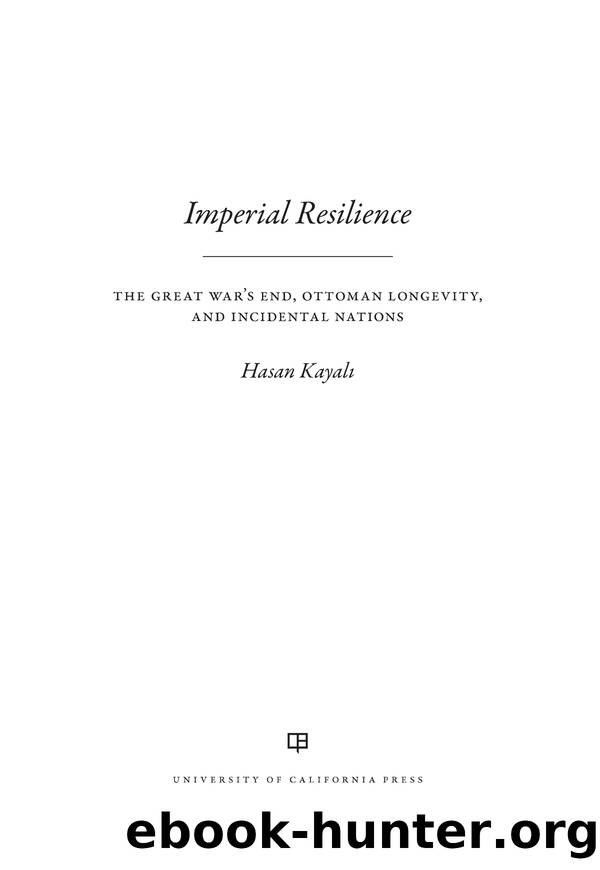Imperial Resilience by Kayali Hasan;

Author:Kayali, Hasan;
Language: eng
Format: epub
ISBN: 6714449
Publisher: University of California Press
FAYSALâS SETBACK IN PARIS AND EXPANSION OF JOINT RESISTANCE BY POPULAR GROUPS
Two weeks before the peace conference closed on January 21, 1920, Faysal arrived in Beirut from his second trip to Paris within a year having failed to influence the Allies to agree to independence for Syria.23 Faysalâs inability to procure an agreement, which would have bolstered his position in Damascus, strengthened the tendency in Syria to seek greater cooperation with the Anatolian groups, whose resistance against French occupation achieved its first successes in MaraÅ in February 1920 and emboldened the anti-colonial forces.24 The ARDRS leadership sent loyal young officers to the occupied provinces to assist in the coordination of local forces, among them Captains Kılıç Ali and Kamil Polat, who fought in the skirmishes that broke out in MaraÅ between the militias and the French troops amid destruction and hundreds of deaths and other casualties.25 Groups in Syria explored joint defense with the Anatolian militias. Just before Faysal returned to Syria empty-handed, his deputy Amir SaÊ¿id al-Jazaâiri had commissioned two Syrian notables to establish contact with the Anatolian resistance: Saâid Haydar, a Lebanese who had studied law in Istanbul and possessed Arab nationalist credentials as a founding member of al-Fatat; and Badiâ Bakdash, a former Ottoman officer from Syria with multiple family links by marriage to high Ottoman officials. The two emissaries met with associates of Mustafa Kemal in Istanbul and drafted an agreement that included the unification of military forces under a single command from southern Jordan to the Black Sea. âIn the event of the successful outcome of their efforts against the West, the Arabs and the Turks will live side by side in two independent states but their relations will be nearly on the same lines as the relations of Austria and Hungary in the pre-War Austro-Hungarian Empire.â26 If such an agreement ever had a chance to be approved and implemented, the diplomatic push in Europe toward the establishment of mandates thwarted it during the drawn-out trip of the envoys, who returned to Damascus in April.
More spontaneous collaboration manifested itself on the ground between militia forces in southeastern Anatolia and northern Syria. A circular Mustafa Kemal sent to army commanders on January 24, 1920, made manifest the Anatolian movementâs ties with Syria. Kemal indicated that a popular organization (teÅkilat-ı milliye) had materialized in that part of the Aleppo vilayet claimed by the Arab government, which was making âevery effort not to separate from the Ottoman community under any circumstance.â Division commander Lieutenant Colonel (Kaymakam) Emin (Amin?) Bey, together with Shakir Niâmat at the same rank, belonged to this organization. The circular recommended a pincer action against the French forces occupying MaraÅ and Pazarcık to its south to be executed by the Aleppines and a popular militia in the north yet to be constituted.27 In a diplomatic initiative, Shakib Arslan, propagandist for Cemal Pasha during the Great War and now advisor to Faysal, wrote to a Russian diplomat purportedly in the name of Faysal, that âFaisul has learnt a bitter lesson in France.
Download
This site does not store any files on its server. We only index and link to content provided by other sites. Please contact the content providers to delete copyright contents if any and email us, we'll remove relevant links or contents immediately.
| Anthropology | Archaeology |
| Philosophy | Politics & Government |
| Social Sciences | Sociology |
| Women's Studies |
The Secret History by Donna Tartt(18133)
The Social Justice Warrior Handbook by Lisa De Pasquale(11949)
Thirteen Reasons Why by Jay Asher(8436)
This Is How You Lose Her by Junot Diaz(6427)
Weapons of Math Destruction by Cathy O'Neil(5818)
Zero to One by Peter Thiel(5480)
Beartown by Fredrik Backman(5340)
The Myth of the Strong Leader by Archie Brown(5233)
The Fire Next Time by James Baldwin(5011)
How Democracies Die by Steven Levitsky & Daniel Ziblatt(4950)
Promise Me, Dad by Joe Biden(4906)
Stone's Rules by Roger Stone(4849)
100 Deadly Skills by Clint Emerson(4683)
A Higher Loyalty: Truth, Lies, and Leadership by James Comey(4544)
Rise and Kill First by Ronen Bergman(4542)
Secrecy World by Jake Bernstein(4382)
The David Icke Guide to the Global Conspiracy (and how to end it) by David Icke(4375)
The Farm by Tom Rob Smith(4320)
The Doomsday Machine by Daniel Ellsberg(4240)
